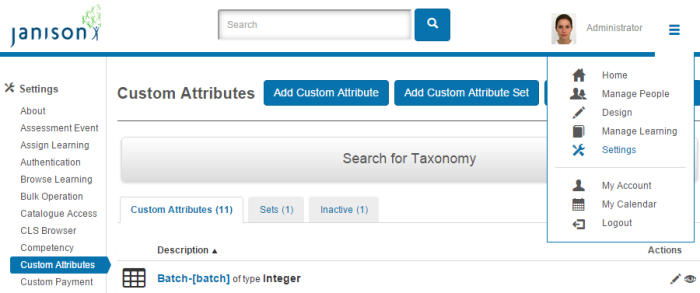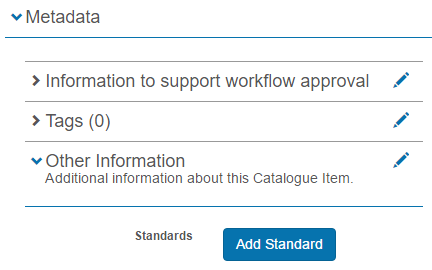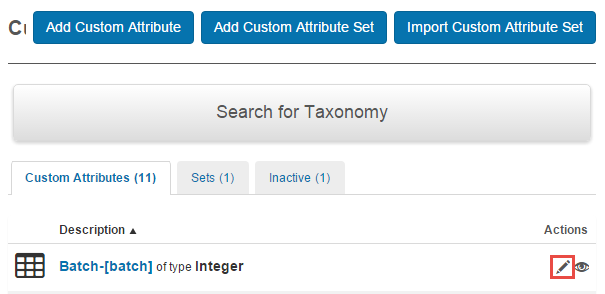Welcome to the Janison Academy help portal
Settings
Custom Attributes allow system administrators to define additional data fields. These fields can be linked to Objects (entities) in the CLS and then used to filter, sort, search and report on these Objects. Custom attributes can also be grouped into sets. Examples of objects that these fields can be linked to are Users, Organisations and Questions.
The following entities in the CLS can have Custom Attributes:
A special use of Custom Attributes is data collection from Users when they self-enrol, see Custom Attributes and Self Enrolment Questions.
Custom Attributes can be reached by selecting Settings > Custom Attributes

The Custom Attributes screen is divided into: Custom Attributes, Custom Attribute Sets and Inactive Attributes and Sets.


Custom Attribute Sets have an additional icon under the Actions heading (3), the download arrow, that enables you to export them to disk.

Custom Attributes can be added by selecting Settings > Custom Attributes then clicking Add Custom Attribute
To add a Custom Attribute
There a several types of Custom Attributes available.
Custom View allows Custom Pages to be displayed wherever custom attributes can be shown. It can also serve as a data store for information from those custom pages. It can be used to allow forms to be displayed and user responses stored.
Note that a Custom Page can be built to fulfil many purposes. It will generally be a requirement for Janison developer to build the Custom Page. You can contact the Janison customer services team to find out more. You can also find out more in our document on Custom Pages.
1. Select the Type of Custom View.
2. Select a previously constructed Custom Page.
3. Enter the Button Text.
4. Add the Linked Objects. In this example we linked it to Catalogue Item.

5. Select Save Custom Attribute.

Note that for the Custom Attribute to be used in a Catalogue Item, it must be linked to a Custom Attribute Set.
The Standards Selector button appears in a sub section of Metadata of the Catalogue Item. It can be used by the Catalogue Item author to undertake the tasks set up in the Custom Page.

This Custom Attribute allows a value to be selected from a drop-down list (for single select lists).
Under Elements you enter the items (Elements) on the list:
Optionally add a Value
After attaching this Custom Attribute to the User Object with the caption ‘geographical region’, updating a User now includes a new drop-down list:
This Custom Attribute displays a checkbox.
After attaching this Custom Attribute to the User Object with the caption ‘Post Graduate Education?’, updating a User now includes a new checkbox:

This Custom Attribute allows the free entry of text that can optionally be restricted by a regular expression
After attaching this Custom Attribute to the User Object with the caption ‘Hobbies’, updating a User now includes a new free text entry box:

This Custom Attribute is similar to List but it has a simpler setup. Separate Identifier and Value text is not entered and there is no control over the display
After attaching this Custom Attribute to the User Object with the caption ‘Expertise’, updating a User now includes a new field:
This Custom Attribute is the same as Selection however it allows the User to also enter a value that is not defined in Elements by typing an entry.
After attaching this Custom Attribute to the User Object with the caption ‘Other Areas of Expertise’, updating a User now includes a new drop-down list.
Selecting ‘Other’ gives the opportunity to enter text in the field containing the paler text ‘Please specify’:
This Custom Attribute is similar to String but it provides a larger text entry area. The maximum length cannot be set.
After attaching this Custom Attribute to the User Object with the caption ‘More details about family background’, updating a User now includes a new field:
This Custom Attribute allows the entry of whole numbers within a defined boundary..
After attaching this Custom Attribute to the User Object with the caption ‘geographical region’, updating a User now includes a new field which only allows the entry of integers (whole numbers):
This Custom Attribute allows the entry of any (rational) number, for example numbers with decimal points.
After attaching this Custom Attribute to the User Object with the caption ‘Coffees per day (average)’, updating a User now includes a new field which only allows the entry of decimal numbers:

This Custom Attribute allows a date to be entered from a date picker..
After attaching this Custom Attribute to the User Object with the caption ‘Date started position’, updating a User now includes a new field. Clicking the calendar icon activates the date-picker:
This Custom Attribute allows an image to be uploaded. The image will be displayed on the details page, and in edit mode the filename will be displayed along with a select button to browse the User’s computer to upload a new image. Supported file extensions are jpg, png and gif.
Height The height in pixels of the image when it is displayed.
After attaching this Custom Attribute to the User Object with the caption ‘Upload a photo’, updating a User now includes:
To edit a Custom Attributes select Settings > Custom Attributes. Click the pencil icon to the right of the Custom Attribute that you want to edit.

The next screen will be similar to the adding a Custom Attribute, see Add Custom Attribute for details.
Custom Attributes can be added by selecting Settings > Custom Attributes then clicking Add Custom Attribute Set
A set of Custom Attributes can be exported to a zip file as a method of moving it to a different site. Browse to Settings > Custom Attributes and click the Sets tab.

Locate the required Custom Attribute Set in the list and click the button found in the Actions column.
button found in the Actions column.

The file will save to your local machine.
To import a Custom Attribute Set browse to Settings > Custom Attributes > Import Custom Attribute Set.


Custom Attribute Sets containing one or more Custom Attributes can be used to collect information from Users when they self-enrol in a Catalogue Item. These Custom Attribute Sets are referred to as Question Sets in Catalogue Items.
Question Sets could be used to:
To create a Question Set:
Below is an example of two Custom Attributes in a Custom Attribute Set. A List type has been used in this example but any Custom Attribute type can be used.

The question sets can be added to a catalogue item or a learning event.
To add the questions to a catalogue item, browse to your Catalogue Item, enter edit mode and open the Self Enrolment Settings section. In the Enrolment Question Set drop-down, select your question set and Save the Catalogue Item.

Learners enrolling in the Catalogue item will be presented with the questions as shown below.

To add the questions to a Learning event, open the learning event and select the icon in the Attendee Questions section. Select the Attendee Question Set and Save.
icon in the Attendee Questions section. Select the Attendee Question Set and Save.

Note: Learners will only be presented with the question sets if the Self Enrolment Method does not involve auto enrolment. For example if the Self Enrolment Method is set to No approval, enrol and launch immediately, Learners will bypass the question set and be taken straight to the Learning Asset.
To view the data collected from the Question Set, a report can be created using Enrolment as the entity.

Below is an example of the report output. For further information on how to create reports please see the document on Customisable Reports.

1300 857 687 (Australia)
+61 2 6652 9850 (International)
ACN 091 302 975
ABN 35 081 897 494
© 2024 Janison
Janison acknowledges the traditional owners of the land on which we work and meet. We acknowledge the continuous care of the land, animals and waterways. We pay our respects to Elders past, present and emerging.